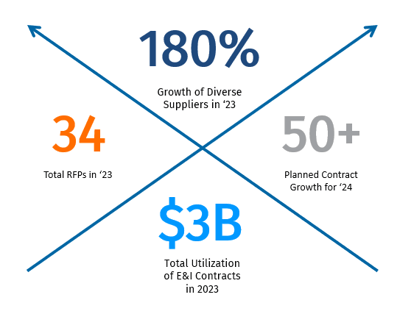
An E&I 2-Minute Read Article
The True Costs of an RFP - Key Takeaways from the NCPP
2024Summarizing the Article
NCPP: RFP Tracking Project
The National Cooperative Procurement Partners (NCPP) organization released a study (September 2024) that outlined the true costs associated with higher education institutions conducting their own RFPs. Understanding the true costs associated with staffing, advertisements, and TIME provides institutions with a transparent look into whether or not conducting their own RFP is cost-effective. The reality is that even the simplest projects consume more than a week's worth of a staffer's time and can take up even more. Below are 5 key takeaways from the article.
1. RFP Processes Are Resource-Intensive
The report highlights the significant personnel hours required to manage a Request for Proposal (RFP) or Invitation to Bid (bid) process. On average, a project takes 87.1 hours to complete. Complex projects, such as those exceeding $1M in budget or requiring construction services, consume 138.7 hours, while non-complex projects take about 42.9 hours. These findings emphasize the resource intensity of public procurement, suggesting that higher education institutions should evaluate whether an RFP is the most efficient procurement method, given the personnel costs involved.
2. Initial Stages of RFPs Are Time-Consuming
The most time-intensive phase of the RFP process is the Initial Stages and Publication, consuming about 50% (43.9 hours) of the total time. In complex projects, this stage takes up to 77.4 hours, compared to just 15 hours for non-complex projects. Key activities in this phase include developing specifications and the scope of work, which are often led by subject matter experts. For higher education procurement teams, streamlining this phase could lead to substantial time and cost savings, especially for lower-complexity projects.
3. Personnel Costs Vary Significantly by Project Complexity
Personnel costs represent a substantial portion of the overall cost to complete an RFP. For complex projects, the total cost averages $17,419, while non-complex projects average $1,682. The largest contributor to this cost is the customer lead or subject matter expert (SME), who contributes approximately $7,705 to complex projects. These figures are important for institutions, as they reveal the true financial burden of internal labor in RFP processes, providing a basis for justifying budget increases or additional staff.
4. Minimal Direct Advertising Costs
Despite the high personnel costs, direct advertising costs are minimal for most entities due to the widespread adoption of eProcurement systems. For projects that reported advertising expenses, costs ranged from $70 to $1,300. Higher education institutions should evaluate whether their current methods of advertisement are cost-effective and consider fully transitioning to digital platforms if not already doing so, to further minimize costs and broaden outreach to potential vendors.
5. Need for Continuous Data Collection and Refinement
The report concludes that tracking RFP costs is an ongoing process that could benefit from further refinement and expansion. The study found wide variations in costs, with some entities not recording key phases like the Negotiation and Award process, skewing the data. As more institutions, including those in higher education, begin to participate in similar tracking initiatives, cost estimates will become more accurate and potentially sector-specific. This could lead to better strategic decisions regarding procurement, particularly in determining when to pursue cooperative contracts instead of conducting an internal RFP.
Related Links:
Download the entire report from the NCPP, here.
True Costs of an RFP - Podcast - Interview with Tammy Rimes from the NCPP
E&I Competitively Solicits Contracts for You - Saving your $$.
As a member-owned GPO, we can save you time and money - highlighted in the article from the NCPP.

Contract Growth YTD
E&I had 42 contract activations and increased our overall portfolio to 238 total contracts and growing, up from just over 160. This expansion in offerings includes new mental health resources, electric vehicles, and continued expansion of our technology partners.
Added RFPs and Supplier Diversity Options
E&I increased our total RFPs in 2023 by 325%. Moving from 8 in 2022 to 34 in 2023 enabled our contract portfolio to expand, adding more options that enable you to support your institution's purchasing initiatives in the future. In 2023, member purchases topped $3 billion.

E&I Cooperative Has Procurement Contracts You Can Access
You received this newsletter because E&I has many contracts that your procurement department has special pricing for. Click below to learn more about a few of them. E&I is your partner in collegiate and K-12 procurement needs. Through our contract portfolio, we help our member institutions make quick and informed purchase decisions.
Deloitte
The Deloitte contract helps schools and universities with hands-on practical solutions to maximize academic, operational, student lifecycle, and strategic success. Deloitte bring big ideas and practical solutions to advance teaching, learning, research, and community service.
Staples Business Advantage - Promotional
This contract delivers the products you school needs to represent your institution's brand effectively. In addition to a wide assortment of logoed items from over 150 suppliers, this contract also offers solutions expertly tailored to efficiently coordinate the licensing, control, and acquisition of branded merchandise.
ctp (Collegiate Travel Planners)
Collegiate Travel Planners provides travel management to over 130 universities and colleges nationwide. The E&I contract includes air, car, and hotel discount programs, lowest airfare guarantee, unused ticket management, traveler tracking and compliance, and credit card reconciliation.
Why Members Work With E&I?
6,000+
U.S. member institutions, universities, and K-12
200+
Member solicited buying
contracts you can access
$3B+
Yearly spend of E&I members
means large savings for you



